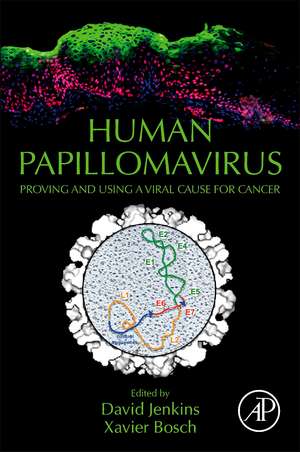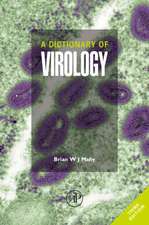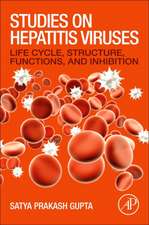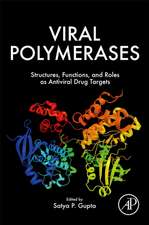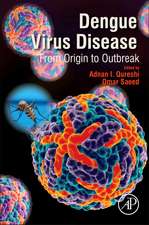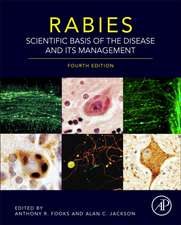Human Papillomavirus: Proving and Using a Viral Cause for Cancer
Editat de David Jenkins, Xavier Boschen Limba Engleză Paperback – 25 noi 2019
- Presents a comprehensive, up-to-date review of the role of HPV in cancer from those involved in its study
- Includes the way evidence on the role and utility of HPV based prevention has been accumulated over almost 40 years
- Gives a series of vignettes of individual scientists involved in the development of the science of HPV and cancer at different stages and their experiences and reasons for involvement
Preț: 556.57 lei
Preț vechi: 757.31 lei
-27% Nou
Puncte Express: 835
Preț estimativ în valută:
106.50€ • 111.49$ • 88.12£
106.50€ • 111.49$ • 88.12£
Carte tipărită la comandă
Livrare economică 31 martie-14 aprilie
Preluare comenzi: 021 569.72.76
Specificații
ISBN-13: 9780128144572
ISBN-10: 0128144572
Pagini: 460
Dimensiuni: 191 x 235 x 28 mm
Editura: ELSEVIER SCIENCE
ISBN-10: 0128144572
Pagini: 460
Dimensiuni: 191 x 235 x 28 mm
Editura: ELSEVIER SCIENCE
Public țintă
Clinical and scientific virology and cancer research, public health, diagnostic and pharmaceutical industries, modern medical history and sociologyGraduate level scientists in virology, molecular biology, pathology, screening, vaccines and epidemiology and public health.
Cuprins
Section 1: Early questions and their slow answers
1. Introduction: Implications and responses to a possible specific infectious cause for a solid cancer, approaches to proving the role of HPV, and exploring its potential uses against conventional medical practice
2. Cervical and other cancers now associated with HPV prior to recognition of HPV in cervical cancer
3. Cervical screening and its basis in ideas of precancer in classical microscopic pathology
4. The "discovery" of HPV I6 in cervical cancer and studies of its transforming role, P53 and pRB
5. Growing numbers of carcinogenic papillomaviruses and understanding of their differences
6. The impact of HPV on conventional morphological pathology of cancer and precancer. Bethesda classification, molecular markers relating morphology to molecular mechanisms
7. The proof of causality in humans
8. Progression from infection to cancer
9. Sexuality and HPV: sexual transmission, male role
10. Genital warts
11. HPV and non-cervical cancer
12. Immune responses, and antibodies to HPV, making viral antigens
13. Developing and standardising HPV tests
14. HPV and non-HPV pathways to cancer
Section 2: Prevention of cancer and HPV infection
15. Introduction: Evidence-based medicine, HPV and cancer prevention
16. Triage of women with low-grade smear abnormalities and HPV testing, HC1 and 2, GP5+/6+, ALTS trial, Netherlands, other trials
17. Primary screening by HPV testing
18. Prophylactic vaccines, proving their value and the role and limitations of the pharmaceutical industry and its regulators, safety and efficacy
19. Modelling disease, prevention and cost-effectiveness – a developing process, different types of models, what does cost-effectiveness mean?
20. Changing global concerns about screening and vaccination
1. Introduction: Implications and responses to a possible specific infectious cause for a solid cancer, approaches to proving the role of HPV, and exploring its potential uses against conventional medical practice
2. Cervical and other cancers now associated with HPV prior to recognition of HPV in cervical cancer
3. Cervical screening and its basis in ideas of precancer in classical microscopic pathology
4. The "discovery" of HPV I6 in cervical cancer and studies of its transforming role, P53 and pRB
5. Growing numbers of carcinogenic papillomaviruses and understanding of their differences
6. The impact of HPV on conventional morphological pathology of cancer and precancer. Bethesda classification, molecular markers relating morphology to molecular mechanisms
7. The proof of causality in humans
8. Progression from infection to cancer
9. Sexuality and HPV: sexual transmission, male role
10. Genital warts
11. HPV and non-cervical cancer
12. Immune responses, and antibodies to HPV, making viral antigens
13. Developing and standardising HPV tests
14. HPV and non-HPV pathways to cancer
Section 2: Prevention of cancer and HPV infection
15. Introduction: Evidence-based medicine, HPV and cancer prevention
16. Triage of women with low-grade smear abnormalities and HPV testing, HC1 and 2, GP5+/6+, ALTS trial, Netherlands, other trials
17. Primary screening by HPV testing
18. Prophylactic vaccines, proving their value and the role and limitations of the pharmaceutical industry and its regulators, safety and efficacy
19. Modelling disease, prevention and cost-effectiveness – a developing process, different types of models, what does cost-effectiveness mean?
20. Changing global concerns about screening and vaccination
